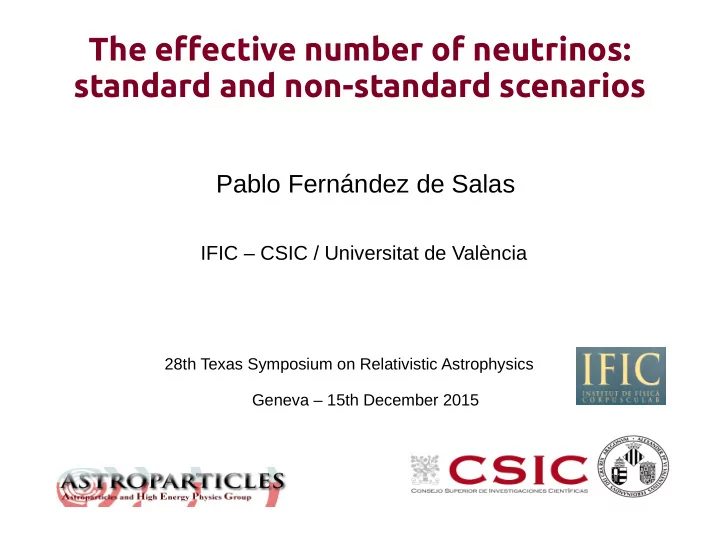

The effective number of neutrinos: standard and non-standard scenarios Pablo Fernández de Salas IFIC – CSIC / Universitat de València 28th Texas Symposium on Relativistic Astrophysics Geneva – 15th December 2015
Radiation-dominated epoch of the universe The universe has passed through epochs of domination of different components
Radiation-dominated epoch of the universe The universe has passed through epochs of domination of different components During the radiation-dominated era
Radiation-dominated epoch of the universe The universe has passed through epochs of domination of different components During the radiation-dominated era
Neutrino decoupling and e e annihilations ⁺ ⁻ Instantaneous decoupling approximation: 1) Neutrinos decouple completely 2) e⁺e⁻ annihilate
Neutrino decoupling and e e annihilations ⁺ ⁻ Beyond the Instantaneous decoupling approximation: Neutrino decoupling and e⁺e⁻ annihilations were not ● fully disconnected After e⁺e⁻ annihilations: & ●
Effective number of neutrinos N eff accounts for any contribution to radiation other than photons Standard scenario : only neutrinos → N eff ≈ 3 Another definition Measured value : N eff = 3.04 ± 0.18 (68% C.L.) Planck TT,TE,EE+lowP+BAO
Deviation from N eff = 3 due only to neutrinos Neutrino decoupling is not complete when e e annihilate ⁺ ⁻ ● Finite temperature QED corrections ● Non-Standard neutrino-electron Interactions (NSI) ● Very Low-Reheating scenarios (N eff < 3) ●
Finite temperature QED corrections Particles are in a thermal bath with a temperature T ● Photons and electrons acquire an additional effective mass ●
Neutrino decoupling not complete when e± annihilate → Deviation of f ν from equilibrium Main source of deviation ⁻ ⁺ Interactions with e and e ● Also important Neutrino oscillations ● Neutrino self-interactions ●
Neutrino decoupling not complete when e± annihilate → Computing the deviation from equilibrium Density matrix formalism Solve Boltzmann equations with I coll ≠ 0
Neutrino decoupling not complete when e± annihilate → Collision integrals treatment When oscillations are added we need to solve 9 collision integrals, one for each real entry of the density matrix Reduce analytically from 9 to 2 integrals ● Solve numerically with a grid on the incoming neutrino momentum ● We do not consider damping factors ● for the off-diagonal terms of the density matrix
Neutrino decoupling not complete when e± annihilate → Collision integrals treatment When oscillations are added we need to solve 9 collision integrals, one for each real entry of the density matrix Reduce analytically from 9 to 2 integrals ● Solve numerically with a grid on the incoming neutrino momentum ● We do not consider damping factors ● N eff = 3.044 for the off-diagonal terms of the density matrix
Non-Standard neutrino-electron Interactions 3.040 ≤ N eff ≤ 3.059 D.V. Forero & M.M. Guzzo (2011)
Very Low-Reheating scenarios The last radiation-dominated era of the universe usually arises from the decaying of a massive particle, a process known as reheating Standard case: N eff = 3.046 In the specific scenario where the so-called reheating temperature is as low as T RH ~ few MeV, neutrinos do not have time to thermalize. This affects their contribution to the radiation content of the universe P. F. de Salas et al (2015) PRD in press (arXiv:1511.00672)
Very Low-Reheating scenarios → Neutrino production in LR scenarios We assume a massive particle ϕ ● decaying into relativistic particles other than neutrinos Neutrinos will be populated via weak ● interactions with charged leptons P. F. de Salas et al (2015) PRD in press (arXiv:1511.00672)
Conclusions and results Standard scenario N eff = 3.044 → Neutrinos only Non-Standard Interaction (NSI) scenario 3.040 ≤ N eff ≤ 3.059 → neutrino-electron NSI No significant possible deviation from the standard case Low-Reheating scenarios → Bound from BBN (95% C.L.) → Bound from CMB (95% C.L.) Can be interpreted as
Backup
N eff and Σm ν simultaneous constraint
Why not to consider damping factors
Why not to consider damping factors
Recommend
More recommend